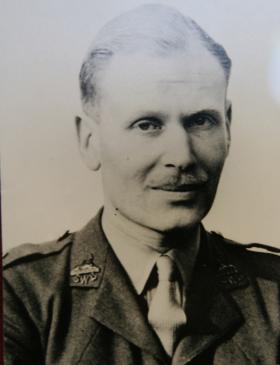The ‘Airborne Hospital’ at Apeldoorn and Lieut-Colonel. K.B.I. Smyth, OBE.
By Geert Jonker. O.C: Recovery and Identification Unit, Netherlands.
The vast majority of Allied wounded from the Arnhem battle were transferred to one of the medical facilities in the city of Apeldoorn. Some 25 kilometers to the north, and renowned for the Dutch royal family’s summer palace ‘Het Loo’.
The Apeldoorn R.C. St. Joseph’s Psychiatric Hospital (Penintent Order) had been commandeered by the Germans the year before, and was now operating as Kriegslazarett 4/686; a German regional military hospital. St. Joseph’s soon became flooded with both German and Allied wounded from the battlefield. German command therefore designated two local infirmaries as ‘Teillazarett’ or annex; the R.C. St. Liduïna Hospital and the Municipal Algemeene (general) Hospital. In these two local hospitals under Dutch medical staff, the more seriously wounded were treated.
On 13 October 1944, Lieut-Colonel. Kenneth Smyth was transferred from the Arnhem St. Elisabeth’s Hospital to the British administered ‘Airborne Hospital’. It had been established, as an ad-hoc arrangement, on 24 September in the Koning Willem III Dutch Army barracks, and was under the command of Colonel. Graeme Warrack RAMC - the Airborne Division’s senior medical officer. The Airborne Hospital was locked down and guarded by a German garrison. Apparently Lieut-Colonel. Smyth had been with the party of medical staff and some thirty patients which until 13 October had been allowed to remain at St. Elisabeth’s Hospital, and at immediate notice had now been sent to Apeldoorn. On arrival at the Airborne Hospital it was assessed that the nature of Lieut-Colonel. Kenneth Smyth’s stomach injuries was way too serious to keep him there. Apparently the transfer to Apeldoorn had not done his medical condition any good either. He needed intensive medical care, in a proper hospital.
According to the German hospital entry book of ‘Teillazarett 4/686, Algemeines Krankenhaus’ (Municipal Algemeene Hospital), 36876. Lt-Col. K.B.I. Smyth was admitted on Friday 13 October 1944, under No. 252, having been transferred from the Airborne Hospital - a five minute drive by ambulance.
Despite his injuries, Smyth himself had been able to state his details (R-N-N) as well as the address of his wife, who was staying in Scotland: 15 Royal Circus, Edinburgh. The nature of his wounds was described by the medical clerk as: ‘sustained at Arnhem on 23-09-1944 [sic], wounds to the stomach, graze to the left hand, gunshot wound through the right hand.’
Despite the intensive medical care and devotion from the Dutch staff, Lieut-Colonel. Kenneth Smyth was not to recover from his injuries. He passed away in the Algemeene Hospital on Thursday 26 October, aged 38. His body was taken to the mortuary and buried on Monday 30 October, in the Apeldoorn ‘Heidehof’ General Cemetery, grave 4-342, coffin No. 283. He was buried at the same time as, and next to Pte. Robert Jackson of The Border Regiment, who had been a member of the 1st Airlanding Brigade’s Defence Platoon and had died of wounds at St. Joseph’s Hospital on 23 October. Usually these burials were attended by a padre and senior representatives of the British medical staff, a small number of whom were even allowed to move freely between the various medical facilities in Apeldoorn.
On 4 October 1945, No. 37 British Graves Registration Unit (GRU) exhumed the body of Lt Col Kenneth Smyth from the grave in Heidehof Cemetery. His remains were transferred to the newly established ‘Airborne’ Arnhem-Oosterbeek War Cemetery, grave 18-B-8. The personal inscription on his headstone, provided by his loved-ones reads: ‘Sleep after toil; port after stormy seas; ease after war.’
Source:
Geert Jonker and R Hilton
Read More





Latest Comments
There are currently no comments for this content.
Add Comment
In order to add comments you must be registered with ParaData.
If you are currently a ParaData member please login.
If you are not currently a ParaData member but wish to get involved please register.